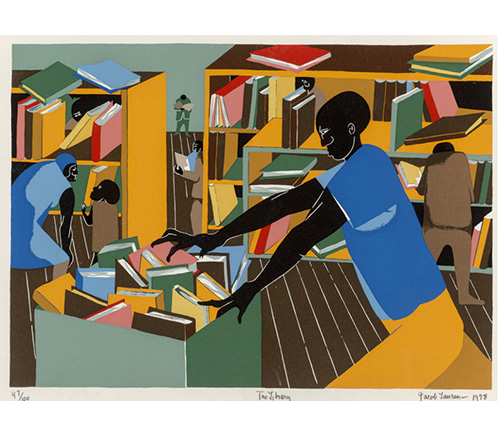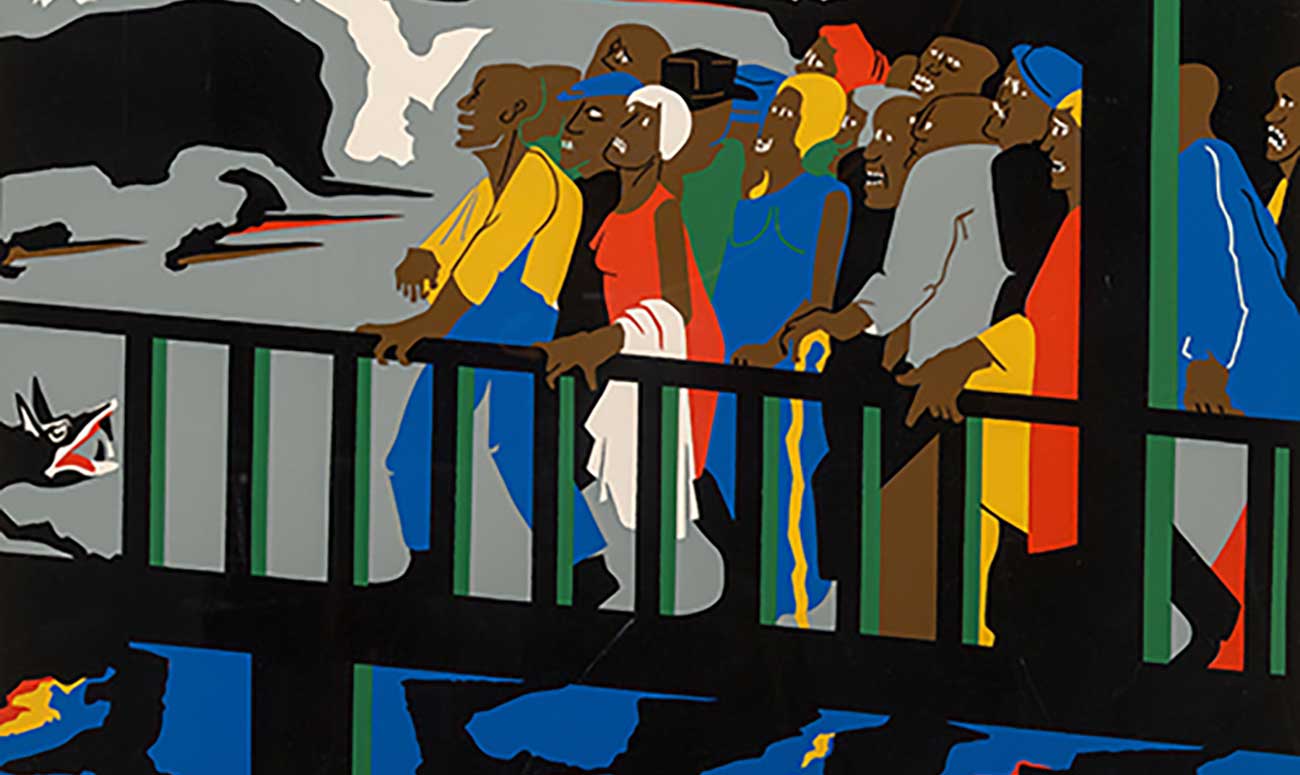Renowned artist Jacob Lawrence showcased in the Larson Gallery’s latest exhibit
This winter the Larson Gallery featured 33 color prints created by the renowned African American artist Jacob Lawrence. The show spanned Lawrence’s career from 1983 to 2000 and included his Genesis, Hiroshima and Toussaint L’Ouverture series. The exhibition was curated by Peter Nesbett, editor of “Jacob Lawrence, The Complete Prints (1963-2000), The Catalogue Raisonne,” and founding director of the Jacob and Gwendolyn Lawrence Foundation.
Since his first published print in 1963 Lawrence produced a body of prints that is both highly dramatic and intensely personal. In his graphic work, as in his paintings, Lawrence turned to the lessons of history and his own experience. From depictions of civil rights confrontations to scenes of daily life, these images present a vision of a common struggle toward unity and equality, a universal struggle deeply seated in the depths of the human consciousness.
Lawrence was born in Atlantic City, N.J., in 1917 and spent his formative years in New York City’s Harlem neighborhood. In the mid-1930s he took art classes sponsored by the College Art Association and the WPA at the Harlem Community Art Center and, following a two-year scholarship to the American Artists School, worked in the easel division of the Federal Art Project. In 1941, Lawrence became the first African American artist included in the permanent collection of New York’s Museum of Modern Art, where he had a one-man exhibition in 1944. He lived and worked in New York City, teaching at numerous schools and universities until 1971, when he accepted a full-time faculty appointment at the University of Washington in Seattle, from which he retired as professor emeritus in 1983. Lawrence died in Seattle in 2000.
Lawrence received numerous awards and honors, including the National Medal of Arts (1990), the NAACP Annual Great Black Artists Award (1988) and the Spingarn Medal (1970). His work has been the subject of several major retrospectives that have traveled nationally, originating in 1986 at Seattle Art Museum, in 1974 at the Whitney Museum of American Art and in 1960 at the Brooklyn Museum.

About the Hiroshima series Lawrence wrote:
“Several years ago I was invited by the Limited Editions Club of New York to illustrate a book of my choosing from a list of the club’s many titles. I selected the book Hiroshima, written by the brilliant writer John Hersey. This work was selected because of its power, insight, scope, and sensitivity as well as for its overall content. My intent was to illustrate a series of events that were taking place at the moment of the dropping of the bomb… August 6, 1945. The challenge for me was to execute eight works: a marketplace, a playground, a street scene, a park, farmers, a family scene, a man with birds, and a boy with a kite. Not a particular country, not a particular city and not a particular people. Is it not ironic that we have produced great scientists, great musicians, great orators, chess players, philosophers, poets and great teachers and, at the same time, we have developed the capability and the genius to create the means to devastate and to completely destroy our planet earth with all its life and beauty? How could we develop such creative minds and, at the same time develop such a destructive instrument? Only God knows the answer Let us hope that some day at some time, He will give us the answer to this very perplexing question.”
About the Genesis series Lawrence wrote:
“I was baptized in the Abyssinian Baptist Church [in Harlem] in about 1932. There I attended church, I attended Sunday school, and I remember the ministers giving very passionate sermons pertaining to the Creation. This was over fifty years ago, and you know, these things stay with you even though you don’t realize what an impact these experiences are making on you at the time. As I was doing the series I think that this was in the back of my mind, hearing this minister talk about these things.”
About the Toussaint L’Ouverture series from the Catalogue Raisionne, its editor, Nesbett, writes:
“These prints are based on 41 paintings from a series also entitled Toussaint L’Ouverture, which was completed in 1938 and is now in the Aaron Douglas Collection of the Amistad Research Center, New Orleans. The paintings were executed in tempera and measure 11 x 19 inches, significantly smaller in scale than the prints. Lawrence reworked many of the images during the process of translating them to silk screen. When an image has been significantly altered from the original, that fact is noted in the catalogue entry. The captions Lawrence provided for the paintings at the time of their execution accompany each of the prints. Toussaint L’Ouverture was a leader in the Haitian revolution. Born a slave, he rose to become commander in chief of the revolutionary army. In 1800 he coordinated the effort to draw up Haiti’s first democratic constitution. However, in 1802, before the Republic was firmly established, Toussaint was arrested by Napoleon Bonaparte’s troops and sent to Paris, where he was imprisoned. He died in prison the following year. In 1804 Haiti became the first black Western republic.”
The works in the exhibition come from the collection of Alitash Kebede of Los Angeles,a friend and associate of Lawrence.
This exhibition made possible through the support of the UDEAL (Universal Design for Equity and Accountability in Learning) Title V Grant for Yakima Valley College.
